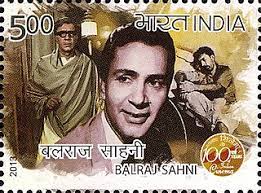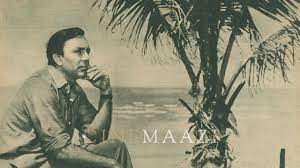By Vikas Datta
 He was out on a Juhu beach building sandcastles with his children when he was offered a challenging role that would go on to make him a Hindi film icon — and nearly lost it when the flabbergasted director saw him turn up in a London-made suit.
He was out on a Juhu beach building sandcastles with his children when he was offered a challenging role that would go on to make him a Hindi film icon — and nearly lost it when the flabbergasted director saw him turn up in a London-made suit.“I found Bimal Roy at his desk, writing something, when I entered his cabin. As he stopped writing and looked up, he appeared to be taken aback. He fixed me with a steady gaze and kept staring at me in silence… After a while, he turned to the people seated at the rear end of the cabin and said to them in Bengali: ‘Is this the man you had in mind? What sort of a joke are you playing on me?’
“Apparently, he wasn’t aware that I knew Bengali. Without even offering me a seat, he said to me, ‘Mr. Sahni, my men have made a mistake. I can see that you are totally unsuited to play the sort of role I wish to present in my film’,” Balraj Sahni wrote in his autobiography ‘Meri Filmi Atamkatha’.
 A shattered Sahni managed to ask what role it was and Roy told him it was of an “uncouth villager”.
A shattered Sahni managed to ask what role it was and Roy told him it was of an “uncouth villager”.
It was Roy who was taken aback when Sahni told him that he had already done such a role in Khwaja Ahmad Abbas’s ‘Dharti Ke Lal’ (1946) — and was also impressed enough to offer him the role of Shambhu Mahato in ‘Do Bigha Zameen’ (1953).
There would be more hiccups ahead, but Sahni overcame them, befriending rickshaw-pullers in Calcutta and closely observing their mannerisms and replicating them meticulously, while also plying a rickshaw to accustom himself.
That was the latent talent of Sahni, who was not the Hindi films’ first ‘natural’ actor — that was his near-contemporary Motilal — but matched by few when it came to diligently researching his varied roles — be it Mahato, Abdul Rehman Khan in ‘Kabuliwala’ (1961), and many more.
 But sometimes, his sense of verisimilitude could be recklessly impetuous too — outdoing Aamir Khan’s train racing stunt of ‘Ghulam’ (1998) over three decades earlier, with Meena Kumari, no less, in ‘Pinjre ke Panchi’ (1966).
But sometimes, his sense of verisimilitude could be recklessly impetuous too — outdoing Aamir Khan’s train racing stunt of ‘Ghulam’ (1998) over three decades earlier, with Meena Kumari, no less, in ‘Pinjre ke Panchi’ (1966).
The scene was to show her walking on a rail track in a suicide bid and he chasing her to stop her, with the train shots to be superimposed. He somehow convinced her and the director to shoot as a train was approaching and it turned out to be a close shave for both of them!
Born on this day (May 1) in 1913 in Rawalpindi in a staunch Arya Samaji family, Yudhisthir Sahni (he changed the name when co-students started calling him ‘Register’) was a non-conformist from his youth, with his younger brother and renowned litterateur Bhisham Sahni recounting how he refused Gurukul education, and wanted to go to a particular Lahore college against the one proposed by his father. And then his habit of talking in English at home annoyed his mother no end!
Like many others of his generation, he was enamoured of films and sought to join Calcutta’s New Theatres after doing his MA in 1936 but it proved abortive and he went back home to the family cloth business.
 But next year, he went back to Calcutta, this time with wife Damyanti. Both got jobs at Visva Bharati, teaching English and Hindi, and interacted with Gurudev Rabindranath Tagore too. In fact, the name of their son Parikshit (born in 1939, not 1944 as most Internet sites show) was suggested by Tagore himself.
But next year, he went back to Calcutta, this time with wife Damyanti. Both got jobs at Visva Bharati, teaching English and Hindi, and interacted with Gurudev Rabindranath Tagore too. In fact, the name of their son Parikshit (born in 1939, not 1944 as most Internet sites show) was suggested by Tagore himself.
The Sahnis then taught at Mahatma Gandhi’s Sevagram before — with the Mahatma’s approval or at least, acquiescence — sailing to London in 1939 where he became a Hindi broadcaster for the Indian Section of the BBC’s Eastern Service.
It was in the BBC that he also made the acquaintance of George Orwell, and in fact, Sahni read out his ‘The Meaning of Sabotage’ on January 29, 1942, detailing not how to undertake sabotage, but how a conquered people could resist their conquerors!
Sahni also convinced the BBC to feature Indian music, particularly K.L. Saigal, to which the management agreed. Meanwhile, his British stint had also made him a Marxist and a fan of Soviet films.
The couple returned to India in 1943, and Sahni was at a bit of a loose end when old friend Chetan Anand invited him to come to Bombay and join films. There, Sahni also joined the IPTA and did some plays too.
While he did some dozen odd films before ‘Do Bigha Zameen’ came his way, most vanished without trace but ‘Hum Log’ (1951), particularly for his speech from the dock in the end, and K. Asif’s ‘Hulchul’ (1951), where he played a jailor while being in jail himself over his Left politics, stood out. As the story goes, Asif had convinced the police chief to allow Sahni out, under escort, in the day to shoot and return to jail at night!

Out of Sahni’s 125-odd later films, including at least two Punjabi ones, the ones that stand out include social dramas such as ‘Seema’ (‘Tu pyar ka sagar hai’, 1955), ‘Chhoti Bahen’ (1959) or ‘Anpadh’ (1962), offbeat love stories like ‘Anuradha’ (1960), pacifist manifestos (‘Aman’, 1967), lost-and-found musicals like ‘Waqt’ (‘Ae mere zohr-e-jabeen’, 1965), crime thrillers (‘Hamraaz’, 1967), and finally, the grim tale of communalism overt and covert, ‘Garam Hawa’ (1973) stand out.
While Sahni acted with all prominent heroes and heroines of his time, he seemed to have a penchant for character actor Jayant (father of Amjad Khan), sharing screen space with him in some of his best performances like ‘Garam Coat’ (1955), war drama ‘Haqeeqat’ (1964), and the grim vendetta tale “Sunghursh” (1968).
Acclaimed by Amitabh Bachchan, who said his father advised him to emulate Sahni “who was in Bollywood yet out of it”, Shabana Azmi, Om Puri, Shah Rukh Khan, and many others, he considered himself more of a literateur.
Bringing a typewriter to sets, he kept on churning stories and has over half-a-dozen books, apart from his candid autobiography, to his credit in both Punjabi and Hindi — in fact, some of the former are on the syllabus in Punjab universities. He also wrote the script of Guru Dutt’s ‘Baazi’ (1951)
Hit hard by the death of his beloved daughter in 1972 — and reliving it through a scene in ‘Garam Hawa’ led to him succumbing to a massive heart attack in April 1973, a few days short of his 60th birthday. Ever the professional, he had just finished dubbing a day before. (IANs)



